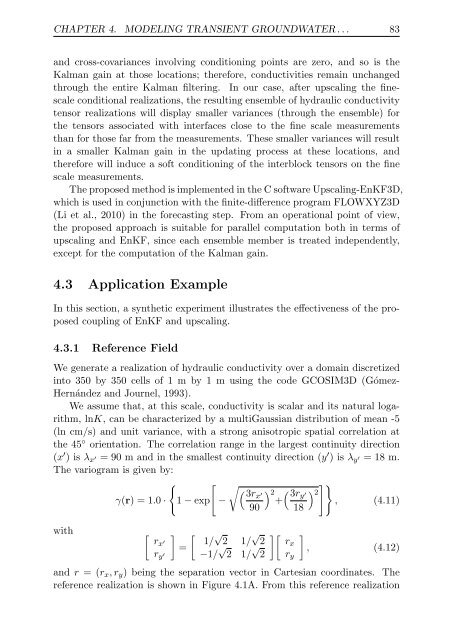Upscaling and Inverse Modeling of Groundwater Flow and Mass ...
Upscaling and Inverse Modeling of Groundwater Flow and Mass ...
Upscaling and Inverse Modeling of Groundwater Flow and Mass ...
You also want an ePaper? Increase the reach of your titles
YUMPU automatically turns print PDFs into web optimized ePapers that Google loves.
CHAPTER 4. MODELING TRANSIENT GROUNDWATER . . . 83<br />
<strong>and</strong> cross-covariances involving conditioning points are zero, <strong>and</strong> so is the<br />
Kalman gain at those locations; therefore, conductivities remain unchanged<br />
through the entire Kalman filtering. In our case, after upscaling the finescale<br />
conditional realizations, the resulting ensemble <strong>of</strong> hydraulic conductivity<br />
tensor realizations will display smaller variances (through the ensemble) for<br />
the tensors associated with interfaces close to the fine scale measurements<br />
than for those far from the measurements. These smaller variances will result<br />
in a smaller Kalman gain in the updating process at these locations, <strong>and</strong><br />
therefore will induce a s<strong>of</strong>t conditioning <strong>of</strong> the interblock tensors on the fine<br />
scale measurements.<br />
The proposed method is implemented in the C s<strong>of</strong>tware <strong>Upscaling</strong>-EnKF3D,<br />
which is used in conjunction with the finite-difference program FLOWXYZ3D<br />
(Li et al., 2010) in the forecasting step. From an operational point <strong>of</strong> view,<br />
the proposed approach is suitable for parallel computation both in terms <strong>of</strong><br />
upscaling <strong>and</strong> EnKF, since each ensemble member is treated independently,<br />
except for the computation <strong>of</strong> the Kalman gain.<br />
4.3 Application Example<br />
In this section, a synthetic experiment illustrates the effectiveness <strong>of</strong> the proposed<br />
coupling <strong>of</strong> EnKF <strong>and</strong> upscaling.<br />
4.3.1 Reference Field<br />
We generate a realization <strong>of</strong> hydraulic conductivity over a domain discretized<br />
into 350 by 350 cells <strong>of</strong> 1 m by 1 m using the code GCOSIM3D (Gómez-<br />
Hernández <strong>and</strong> Journel, 1993).<br />
We assume that, at this scale, conductivity is scalar <strong>and</strong> its natural logarithm,<br />
lnK, can be characterized by a multiGaussian distribution <strong>of</strong> mean -5<br />
(ln cm/s) <strong>and</strong> unit variance, with a strong anisotropic spatial correlation at<br />
the 45 ◦ orientation. The correlation range in the largest continuity direction<br />
(x ′ ) is λx ′ = 90 m <strong>and</strong> in the smallest continuity direction (y′ ) is λy ′ = 18 m.<br />
The variogram is given by:<br />
{<br />
γ(r) = 1.0 ·<br />
with [ rx ′<br />
ry ′<br />
1 − exp<br />
]<br />
=<br />
[<br />
−<br />
√ (3rx ′<br />
90<br />
[ 1/ √ 2 1/ √ 2<br />
−1/ √ 2 1/ √ 2<br />
) 2<br />
+<br />
][ rx<br />
( 3ry ′<br />
ry<br />
18<br />
]}<br />
) 2<br />
, (4.11)<br />
]<br />
, (4.12)<br />
<strong>and</strong> r = (rx, ry) being the separation vector in Cartesian coordinates. The<br />
reference realization is shown in Figure 4.1A. From this reference realization


